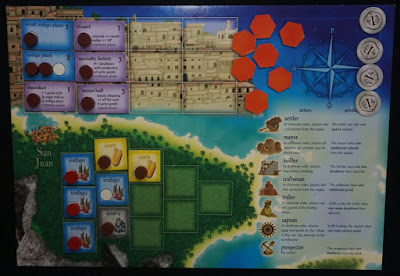Plays: 3Px1.
Puerto Rico used to be the #1 game on BGG. That feels like so long ago. I own the first expansion, and I think I have played it once before. I don't have the second expansion. Ivan bought the recently re-released expansion set containing both expansions, and he brought it to Boardgamecafe.net to play. It was nice playing an old classic again. We were a little extreme. We swapped in all the buildings in the first expansion, thus removing almost all the buildings in the base game. I'm not exactly sure this is a healthy way to play.
Seeing these game components laid out neatly on the table was almost an emotional moment, like seeing one's great aunt again after many years. The first expansion is all new buildings which can be swapped with buildings in the base game. This creates some variability. The plantations don't change. You still have corn plantations, indigo plantations, etc. However there is one special type of plantation called forests. Forests can only be planted using a specific purple building. Two forests act as one quarry, giving you a discount during building construction. This seems weaker, but one advantage of forests is they don't need to be manned, unlike quarries which need to be manned by colonists.
These are component of the second expansion, the nobles expansion. The buildings are not meant to be swapped with the basic buildings. Instead they are all in play and set next to the main board. The red discs are the nobles, and they mostly function as colonists. The only two differences are (1) they are worth 1VP each, and (2) when they operate certain buildings, the powers of the buildings change. A number of buildings in the noble expansion come with two powers, one for when they are manned by a regular colonist, and one for when they are manned by a noble. The noble version is not necessarily better. E.g. the chapel when manned by a colonist generates $1 during the craftsman phase, and when manned by a noble generates 1VP instead. In the early game, that $1 might be more important.
We did a 3-player game, so every round there were 6 actions to pick from. The three unpicked action tiles will each get $1 added. Whoever picks an action tile with money on it keeps the money. The Trader action has not been picked for two rounds, thus the $2 on it.
This was my player board in the early game. Right from the start I decided to focus on indigo production and shipping indigo for victory points. At this point I already had both a large and a small indigo plant. I also had three indigo plantations. My aqueduct would allow the large indigo plant to produce one extra unit of indigo.
I intentionally sent the nobles to work in the plantations. Suffer!
This was Ivan's player board. He was more diversified, producing sugar, indigo and tobacco.
Jeff started off planting much corn. Corn is cheap, but you don't need a production building to process corn. So it is easier to produce. Jeff built a quarry early (bottom left). Early quarries are always good. You will get to use it many times for the rest of the game. It's not just because of the money you save. It is also about the time you save. Sometimes when you try to save enough for an expensive building, it takes a long time. Discounts from quarries can mean being able to afford the building much earlier.
I had two more new buildings on my player board now, both aligned with my indigo shipping strategy. The speciality factory gave me extra income whenever I produced many of the same goods type. E.g. when I produced 4 indigo, I'd earn $3. The union hall gave me extra VP whenever shipping was done. If I had 4 indigo to ship (which could potentially give me 4VP), they would earn 2VP extra for me even before I shipped them. That's 50% extra!
Ivan's player board. Now his tobacco production was in full swing, being able to produce 3 at each craftsman phase. His (light brown) tobacco storage was fully staffed, and his three tobacco plantations too. He had one large building now - the city hall. The city hall gave him 1VP per purple building, including itself.
Jeff later went for a noble strategy. He built a villa, so every time the Mayor action was taken, he would gain an extra noble. He built the Jeweller, which gave him $1 per noble whenever the Craftsman action was taken. Noble themselves were worth 1VP each, so they were lucrative. He built the royal garden large building which gave him an extra 1VP per noble. We were no match for him and eventually he won with a comfortable margin. Jeff took the Mayor action frequently, since it gave him at least 2VP due to the two nobles he would get. He had many surplus workers. In this photo you can see five idle workers (discs).
Cargo ships.
This was my player board at game end. I collected many VP chips, so naturally I built the customs house (large building). It gave me 1VP for every 4VP in VP chips. I had 37VP in VP chips, which meant a bonus of 9VP.












No comments:
Post a Comment